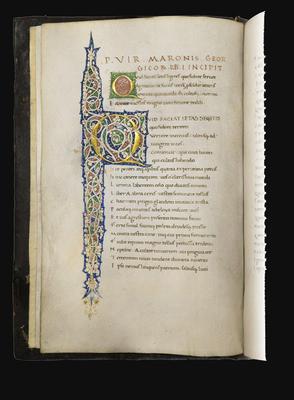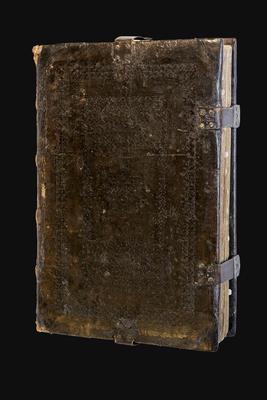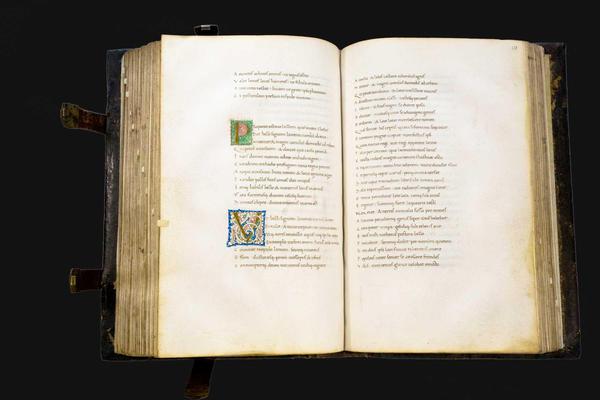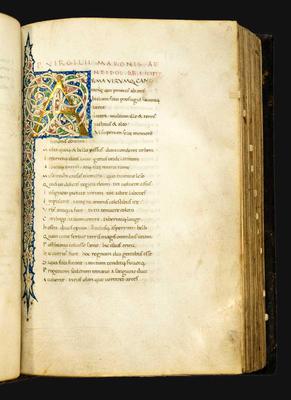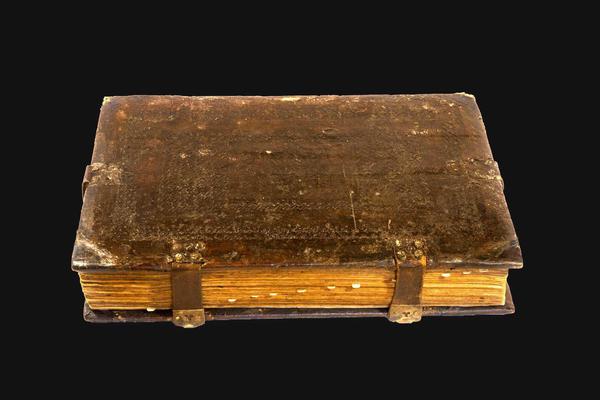Publius Vergilius Maro
Georgica. Aeneis. With argumenta.
Illuminated manuscript on vellum. Florence, ca. 1460-1470.275x180 mm.i+238+iileaves. Complete(with the replacement leaves, see below) but the volume evidently originally included at the beginning sixteen leaves with the Eclogues (an erasure on fol. 1r was probably the end of the Eclogues). Twenty-five quires (one quire of 10 leaves presumably lost). Collation: 110(1/1-6 lost), 2-810, 910(9/1-2 and 9 missing, replaced and numbered 74A, 74B, 80A), 10-2310, 248, 258(most of 25/6, blank except for the colophon, cut away; 7-8 canc.). Blanks: 1r, 44v, 235v. Text block: 170x90 mm, one column, 26 lines. Ruled with dry point. Catchwords written vertically from top to bottom in the inner margin of the last page of each quire (a system of catchwords which Riccius used in his earliest manuscripts). Text written in brown ink in a formal humanist script, signed in the colophon on fol. 238r ‘Nicolaus riccius spinosus vocatus scripsit'. At thebeginning of each work titles in red capitals (fols. 1v, 45r). Fols. 74A, 74B, 80Awritten in 1925 in a skilful imitation of Florentine humanist script by the English calligrapher William Graily Hewitt (1864-1952). On fols. 1v and 45r large gold and vinestem initials with small borders to the left, with clusters of gold-rayed discs and penwork at bottom; vinestem washed in yellow, grounds in brownish red, blue-green and darkish blue, dotted in white or yellow. Thirteen smaller gold initials on square panels of vinestem decoration, and (for the argumenta) fifteen three-line gold initials on blue, green and pink grounds patterned with white and yellow, and with curly outside edges in ink. On the replacement fol. 74Atwo initials – a vinestem initial and a smaller one on a blue and green ground – copied from the originals. Contemporary Florentine dark brown goatskin over wooden boards, panelled in blind with fillets and borders of small knotwork tools and roundels, star-shaped central panel of intersecting squares. Spine cross-hatched; four original metal clasps, leather straps replaced; edges with traces of gilding and gauffering. Some skilful repairs. A fine manuscript, wide-margined. Outer blank margin of fol. 18 cut away, the ink slightly rubbed on a few pages. Some cursive page headings, additions and corrections written by the scribe, a few notes in a later humanistic hand (e.g. fols. 3r, 54r, 54v, 89r). On fol. 70v the first line of the Helen episode ‘Iamque adeo super unus eram, cum limina veste' (Aen.,ii567) was first written, then cancelled by the scribe with ‘va-cat'.
Provenance: Leo S. Olschki, Le livre en Italie à travers les siècles, Firenze 1914, no. 108 (“[on fol. 235] la marge blanche au-dessous de ces 2 lignes surnommés a été decoupée”); Tammaro De Marinis,Vendita all'asta della preziosa collezione proveniente dalla cessata Libreria De Marinis, Milano 1925, no. 211, pl.xliv (“Magnifico codice fiorentino”); bought for 30,000 lire by Sir Sidney Carlyle Cockerell (1867-1962; in his hand the note dated 27 June 1925, regarding the scribe and the replacement leaves written for him by Graily Hewitt); Charles Harold St John Hornby (1867-1946); John Roland Abbey (1896-1969; ex-libris dated 1933; A. Graham – A de la Mare, The Italian Manuscripts in the Library of Major J. R. Abbey, New York 1969, no. 15; Sotheby's, Catalogue of the Celebrated Library of the late Major J. R. Abbey. The Eighth Portion: The Hornby Manuscripts, Part I, London 1974, lot 2930); William Salloch, Catalogue 353. The Classical Heritage, Ossining NY 1978, no. 39.
A fine illuminated manuscript of the works of Virgil, Dante's master and guide in Hell and the greater part of Purgatory. It contains the four books of the Georgica, with the four-line argumenta to each book, and the twelve books of the Aeneis with an argumentum consisting of ten to twelve lines before each book except the first. The codex was written by the scribe who in the colophon signs himself ‘Nicolaus Riccius spinosus vocatus' (the epithet ‘spinosus' means ‘prickly' in English; ‘Riccio' is the Italian for hedgehog), i.e. Nicolò di Antonio di Pardo de Ricci (1434/1435 - ca. 1490), active in Florence in the second half of the fifteenth century; according to Albinia de la Mare, sixtyfour manuscripts are attributable to him, and a number of them are signed with the same formula as here. Riccius was one of the humanist scribes most closely associated with the pre-eminent bookseller or cartolaio Vespasiano da Bisticci (ca. 1422-1498), by 1460 the main provider of books to princes, popes, cardinals, and scholars across Europe. Riccius's hand is found in several classical manuscripts transcribed for the Medici – among themthe famous, and almost contemporary Vergilius Riccardianus 492 – and for Federico da Montefeltro, Duke of Urbino. The quality of the parchment used for the present Vergilius and the exquisite white-vine initials decorating the volume – closely resembling those executed in the Florentine workshop of Apollonio di Giovanni for themsRiccardianus – indicate that this manuscript was commissioned by an important patron. The handsome blind-tooled binding is characteristically Florentine, and very similar to some of those made by Vespasiano da Bisticci for the Duke of Urbino. In 1914 this volume – one of the only two manuscripts included, as “preuves de ressemblance des caractères des premiers livres imprimés avec l'écriture des manuscrits” – was chosen by the renowned bookseller Leo Olschki to represent Italian humanistic manuscript production in the Leipzig exhibition Le livre en Italie à travers les siècles.


